![]()
![]()
![]()
Use LEFT and RIGHT arrow keys to navigate between flashcards;
Use UP and DOWN arrow keys to flip the card;
H to show hint;
A reads text to speech;
58 Cards in this Set
- Front
- Back
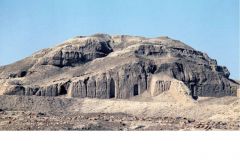
Formal analysis 12. The White Temple and its ziggurat Uruk (modern Warka, Iraq) / Sumerian 3500–3000B.C.E.
Content - This is an architectural piece - The main focus of the piece at the time of creation was the white temple that sat atop the ziggurat - The main focus now is the ziggurat that still remains - The sheer height and size of this ziggurat/temple represents the spiritual power of this piece as a middle ground between god and human
Style - This piece was built out of mud bricks and covered in tar to prevent flood waters from entering - The "white temple" was coated in a chalk whitewash - The artist intentionally used line and shape to create a ziggurat that's corners faced the four directions of the compass - The artist also used the principles of balance and emphasis when putting the temple centered on top of the ziggurat |
The sumerian people were believed to be the one of earliest civilization in the middle east. Many of the ideas we have today were taken from them. This temple and ziggurat, which were later adapted by the egyptians, were used as a middle ground for the gods. It was believed that they could come and go as pleased. However, only a select few non-divine could enter the temple, including priests and attendants. This temple was the pinnacle of the city. It was dedicated to the god Enu and within the temple their was an alter where there would be sacrifices to Enu. |
|
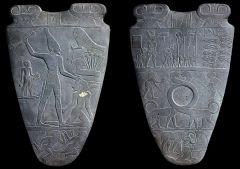
Formal analysis 13. Tablette of King Narmer Predynastic Egypt 3000 - 2,920 B.C.E.
Content - This is a carved stone stele - The subject matter includes people of importance, signs of power and authority, a procession or parade, and animals of some sort - The subject matter is vastly important because it tells a historical narrative
Style - This is a carved stone// carved using a subtractive method (incised piece) - In creating the figures the artist used twisted perspective (development of human figures) - The artist used symbolic hieroglyphics to tell the story - Creates a visual story using registers |
This piece was created to tell the story of King Narmer uniting upper and lower Egypt through violent measures. Traditionally, palettes were used to crush and mix materials to make things such as makeup. However, this is a sacred tablet that is only used for story telling. Each one of the images depicted holds significance as they represent things anywhere from god to animal. The artists intent was to preserve this historical event. |
|
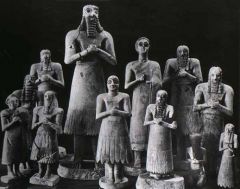
Formal analysis 14. Statues of votive figures from the Square Temple at Eshnunna Modern Tell Asmar, Iraq / Sumerian 2,700 B.C.E.
Content - These are carved stone figurines/statuettes - The subject matter includes realistic depictions of people, praying with eyes wide open - The purpose of this was to portray the people in constant worship
Style - The figures are carved in a subtractive manner either from a cylindrical or brick shaped stone - The artist made all the hands and eyes consistent as a sign of worship to the gods (Stylistic) - Depiction of men vs. women through clothing |
The Purpose of these figures was for the artist to create each figure as a worshipping replica of a real human. The figures would then be placed in the alter so as to be in constant worship of the gods and make the person (depicted in the figure) look better in the eyes of the gods. The hierarchical scale is demonstrate din the size of the figure. Those with more wealth could afford larger figures that would subsequently impress the gods further, resulting in a better after life. One other aspect of the figures was patronism; the buyer paying the artist to create them and represent them well. |
|
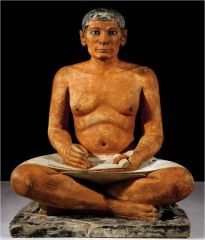
Formal analysis 15. Seated Scribe Saqqara, Egypt / Old Kingdom Fourth Dynasty 2620–2500 B.C.E.
Content - This is a carved limestone piece - The subject matter includes a seated scirbe (hence the name) writing - This is very important because it depicts someone of a lesser status with more natural qualities - This was very unique for ancient egyptian sculpture - Set and broke the norms of egyptian sculpture
Style - Painted/carved limestone (didn’t lose it’s surface pigments) - Skin tone is the raw stone - Naturalistic style and stylized eyes - the modeling of the form is to the point of specific definitions of body parts and movement - subtractive carving methods - stiff frontal position which is characteristic of Egyptian sculpture |
The purpose of this piece is not entirely known. It could have been a funerary piece used to ensure the king has a comfortable afterlife. What we do know is that the style of this piece was very unique and that is what makes this piece so important. Its naturalism is a huge difference form other pieces of egyptian art. |
|
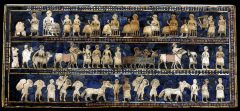
Formal Analysis 16. The Standard of Ur from the Royal Tomb of Ur modern Tell el-Muqayyar, Iraq / Sumerian 2600–2400 B.C.E.
Content - This is a hollow wood box with lapis lazuli inlays - The subject matter includes one side depicting peace and one depicting war - The peaceful side is the king and many of his people at a feast. On the other registers people are bringing food and animals to the feast - On the war side is an image of the kind over dead bodies and multiple different battle scenes. Also, there is animals, carts, and weapons depicted - These figures are majorly important in telling historical naritives
Style - inlays of the incredibly valuable lapis lazuli stone - The figures are shown in twisted perspective (very common in egyptian art) - The main style technique, is the division of the piece into register - This was utterly important in the development of uniform writing |
This was a funerary piece form a royal tomb. We know that it came from the funeral of royalty because of the stone used and its immense value. The piece was put with the dead body to ensure a good afterlife. This piece was also hugely important in the development of uniform writing because it utilized registers and the story went form top-bottom and left-right. |
|
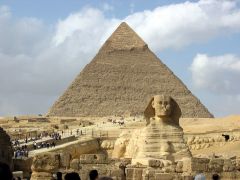
Formal analysis 17. The Great Pyramids (Menkaura, Khafre, Khufu) & Great Sphinx Giza, Egypt / Old Kingdom Fourth Dynasty 2550–2490 B.C.E.
Content - This is an architectural piece - There are 3 pyramids, each dedicated to a different Pharaoh - And there is one sphinx - The pyramids are funerary temples for the Pharaohs - They are significant of the incredible importance of death in Egyptian society
Style - the pyramids and the sphinx are both made of large (carved) pieces of stone - covered in a slick whitewash surface that has worn off - the four corners of each pyramid face the cardinal directions - Built by using slave labor as well as animal labor - |
Each one of the three pyramids were dedicated to one of three pharaohs. Khufu had the first and largest pyramid because he was the most successful and had the longest rule. Following him, was his son, Kahfre. The last and smallest temple was for Menkaura (who was somehow related to the other two as well). Each pyramid was a funerary temple. The dead body of the Pharaoh placed inside, as well as gifts, riches, sculptures, and other things to ensure a comfortable after life. The shpinx stood as a guardian for all of the pyramids. |
|
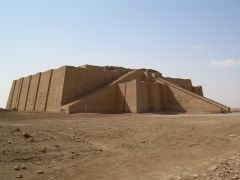
Formal analysis The Ziggurat of Ur Dhi Qar Province, Iraq / Sumerian 2,100 B.C.E.
Content - This is an architectural piece - It was reconstructed by Saddam Hussein - The sheer height and size of this ziggurat represents the spiritual power of this piece as a middle ground between god and human
Style - This piece was built out of mud bricks and covered in tar to prevent flood waters from entering - The artist intentionally used line and shape to create a ziggurat that's corners faced the four directions of the compass - The artist also used the principles of balance and emphasis when putting the temple centered on top of the ziggurat
|
The sumerian people were believed to be one of earliest civilization in the middle east. Many of the ideas we have today were taken from them. This ziggurats, which were later adapted by the egyptians, were used as a middle ground for the gods. It was believed that they could come and go as pleased. |
|
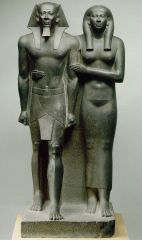
Formal Analysis 18. King Menkaura and Queen Egypt/ Old Kingdom/ Fourth Dynasty 2490-2472 B.C.E.
Content - This is a carved funerary statuary - The subject matter in this consists of the king and queen - This is significant because the King and the Queen were huge figures in Egypt and the fact that they had a statue made to them represents their significance
Style - This is sculpted out of a block of diorite which is a huge indictor of how royal and wealthy the King and Queen were - The figures are portrayed in the stiff, authoritative pose that was common in egyptian sculpture - The artists main job was to portray the king as a god-like figure - Artist captured the wet-drapery style in the clothes that was very accurate to ancient egyptian style - follows the canon of proportion
|
This funerary piece was most likely made during the life of the king. It was ordered that the artist create the king in an idealized divine manner. The statuary was placed in the kings tomb to ensure comfort and success in the afterlife. This piece completely represents ideals of ancient Egypt. The importance of fertility is demonstrated by the emphasized pubic triangle on the queen. Also, the style of the clothing mimics that of ancient Egypt. |
|
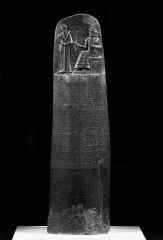
Formal Analysis 19. The Code of Hammurabi Babylon, Modern Iran/ Susian 1,792-1,750 B.C.E.
Content - This is a stone stele - The Subject matter includes King Hammurabi with the flame shouldered god - This demonstrates the connection between god and roayalty - The other part of the subject matter is the laws of Hammurabi - These gave us an insight as to how Hammurabi was so successful in his ruling of Babylonia - Together, the two subject matters demonstrate the connection between the divinity and man as well the God's supposed approval of Hammurabi's laws
Style - This is a freestanding stone stele that is carved out of basalt - The laws are incised within the face of the rock is the ancient mesopotamian language, cuneiform - The figures at the top of the piece are carved using a subtractive technique - relief |
This piece literally served as a way for Hammurabi to communicate his laws. With this piece he kept all the laws in one place and could refer to them when punishment became necessary. This piece also showed the connection between gods law and mans law. |
|
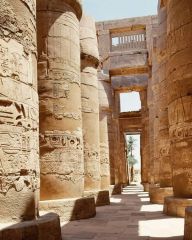
Formal Analysis 20. Temple of Amun-re and Hypostyle Hall of Karnak Near Luxor, Egypt/ New Kingdom/ 18th and 19th Dynasties Temple : 1550 B.C.E. Hall: 1250 B.C.E.
Content -This is a stone temple - The main subject matter includes the front pylon (that also spanned all around the temple), the cause way, the hypostyle hall, and the obelisks - The pylon was a massive stone wall that created the outskirts of the temple - The cause way was very important for religious processions - The hypostyle hall was incredibly important architecture and contributed to the invention of clerestory windows - The obelisks were all made from one block of stone and were very sacred in purpose (reaching towards the sun) and creation
Style - This temple is bilaterally symmetrical and is divided in half by the causeway - Each pillar/pole is individually carved with hieroglyphics and painted (yet still remain smooth in appearance) - The hypostyle hall is constructed using the pole an lintel method - The height gave way to the creation of clerestory windows that allowed light into the temple |
This is a very important temple that set the stage for architecture to come. Each pharaoh that ruled during the time of its creation added to the temple and, in turn, added to the sacredness. The further back that the temple was built, the more sacred area that was being built. In over 250 acres, the temple was home to courtyards, a sacred lake, a sanctuary, and the hypostyle hall. All of these had their own religious and spiritual purposes. |
|
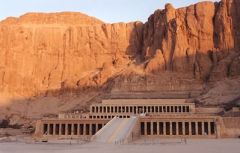
Formal Analysis 21. Mortuary temple of Hatshepsut Near Luxor, Egypt/ New Kingdom/ 18th Dynasty 1,473-1,458 B.C.E.
Content - This is a limestone temple - The main subject matter is the three tiered temple and the nearly 200 statues of Hatshepsut found inside the temple - These statues are very important in Hatshepsut securing and fighting for her rights as a pharaoh. - There is an obvious causeway that divides the temple in two
Style - This temple is half carved into the limestone behind it and half built of limestone - facade of the temple mirrors the natural landscape -colonnades line the front of all three tiers - bilaterally symmetrical on either side of the causeway - statues on columns - filled with granite sculptures - one specific sculpture is the Kneeling Hatshepsut/ houses the ka within the sculpture (ka statue)
|
This temple was major in Hatshepsut's securing of her title as pharaoh. As the first female pharaoh she had to prove her rule through this temple and the many treasures inside. The vastness, as well as the style, demonstrate the strength and longevity of her rule. |
|
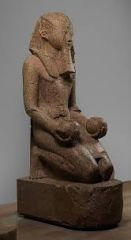
Formal analysis 21. Kneeling statue of Queen Hatshepsut Near Luxor, Egypt/ New Kingdom/ 18th Dynasty 1,473-1,458 B.C.E.
Content -This is a stone statue - The subject matter consists of Queen Hatshepsut kneeling in offering to the Aman-re (the sun god) - The orbs she's holding are most likely ceramic vessels
Style - This is carved using subtracted techniques - Frontal, egyptian position - Depicted with breasts (shows femininity) - Kneeling in offering - Also depicted with official pharaoh wear |
This statue was made during Hatshepsut's life so as to be ready upon her death date. It's purpose was to praise Amun-Re, the sun god. This would ensure that she received utmost comfort in the afterlife. The other purpose of this sculpture was to house the ka. It ensured the spirits entrance into the afterlife. There were over 200 sculptures just like this one within the Mortuary Temple of Hatshepsut. |
|
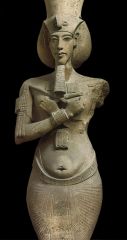
Formal analysis Statue of Akhenaton for Karnak Egypt/ The Armana period 1,375 B.C.E.
Content - This is a carved stone piece - From the Armana period (akhenaton's rule) - The style of this is representative of the style of the entire armana period - The subject matter consists of King Akhenaton depicted in the kingly form of the Arman period
Style - This sculpture is made with an elongated figure an curvilinear edges - The king is depicted in a naturalistic style that contrasts previous egyptian style completely - The naturalism reflects Akehnaton's style and reign over egypt
|
This statue was made to depict the king. It emphasizes his reign over Egypt. The style of the sculpture demonstrates how Akhenaton's power changed the ways of Egypt in the Armana period. This is a sculpture of dominance and power, which is reflected in it's size. |
|
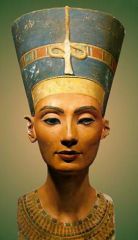
Formal Analysis Nefertiti Egypt/ The Armana Period 1,360 B.C.E.
Content - This is a painted limestone piece - The subject matter consists of Queen Nefertiti's bust - This is very important because it depicts her both naturally and royally, reflecting the style of the Armana period
Style - Three dimentional shape of cheek bones and ears highlights the emphasis on realism that very uncommon - elongated form also highlights the style of the armana period - the ornamentation of her crown as well as her collar demonstrates her importance and wealth
|
This bust was created to portray the queen as natural but still royal and full of power. It highlights the style of the armana period. Since Nefertiti was Akhenaton's wife, it makes sense that her image was depicted similar to his. |
|

Formal Analysis 22. Akhenaton, Nefertiti, and the Three Daughters Egypt/ New Kingdom (Armana)/ 18th Dynasty 1,353-1,335 B.C.E.
Content - This is a bas relief / sunken relief/ incised/ subtractive stone piece - The subject matter consists of King Akhenaton, Queen Nefertiti, and three of their five daughters basking in the glow of Aton, the sun god - This is really important because it is a very intimate portrayal of the royal family
Style - the naturalism of the king kissing his daughter represents the style of the armana period - The hieroglyph of the sun disk and its rays represents Aten - The iconography of the sun disk and it's rays demonstrates how Ahkenaton recreated Egyptian religion in the way that the monotheism, only served him and his wife as higher beings - Ankh shows at the end of the rays near the face of the queen and king, as to suggest Aten giving life to them and them only Also, the figures are dpeicted in twisted perspective... interesting contrast to the rest of the style |
This piece was created to depict the royal family. It was in the style of the Armana period, the period of Akhenaten's rule. It also demonstrates the connection between royalty and divinity as well as the very special connection between Aten and Akhenaten. |
|
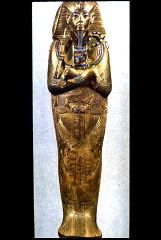
Formal Analysis 23. Tutankhamun’s tomb, intermost coffin Egypt / New Kingdom 1,323 B.C.E.
Content - This a beaten modeled gold coffin - The subject matter consists of a depiction of King Tut in the royal, egyptian style of depicting pharaohs - This coffin was incredibly important because it was sealed off behind another tomb and protected from thieves. When it was found, the entire sarcophagus and all its contents were untouched.
Style - This coffin depicts king tut in the traditional egyptian pharaoh manner (it is modeled and hammered gold) - Decorated with semi-precious stones (lapis lazuli, turquoise, carnelian) - signify wealth - inlaid designs of wings and hieroglyphics
|
King Tut's tomb has gained the popularity and recognition it has from its intactness at the time of discovery. The intermost coffin, itself, housed the body of Tut. It was encased in two more gold coffins which were laid in the sarcophagus and sealed within the tomb. |
|

Formal Analysis 24. The Last Judgement of Hu-Nefer from his tomb (page from the Book of the Dead) Egypt/ New Kingdom / 19th Dynasty 1,275 B.C.E.
Content - This is a painted papyrus scroll - The subject matter inlcudes Anubis (the god of embalment) leading hu-nefer into the scaled of judgement - scale weighs the dead man's heart against the feather of the goddess of truth and right - amit (devourer of the sinful) awaits the decision of the scales - This is important because it tells the story of hu-nefer
Style - The figures are depicted din twisted perspective (classic egyptian style) - very suprising that this section of a 70ft scroll has not disentgrated or the paint has not worn off - story told in registers - images are highly reflective of the religious beliefs of the people (i.e. figures with bird heads) |
The purpose of this scroll was to tell the story of Hu-Nefer's walk into judgement day. It portrays these ideas in classic egyptian style and greatly demonstrates the connection between god and man. |
|

Formal Analysis Temple of Ramses II Abu Simbel Egypt/ New Kingdom 1,225 B.C.E.
Content - This is a stone-cut temple - The main subject matter consists of the inner temple that is cut from the rock and the largely ornamentated entrance - The figure son the front of the temple are over 65 ft. tall and were created to scare off intruders - The inside of the temple there are 36 foot tall columns in the shape of Ramses and osiris
Style
-rock cut temple -completely cut from the rock face -new kingdom architecture -return to the old egyptian style (frontal, strong, idealistic, polytheism)
|
This temple was a funerary temple of Ramses. The temple was erected to the the god of the underworld, osiris to ensure the dead king's comfort in the afterlife. |
|
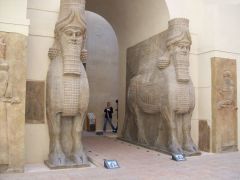
Formal analysis 25. Lamassu from the citadel of Sargon II, DurSharrukin Modern Khorsabad, Iraq Neo Assyrian 720-705 B.C.E.
Content
-last major mesopotamian culture prior to it being broken apart -citadel=fortress that this place came from- walled city -had to get through the sculptures to get in or out -lamassu= mythological creature -head of a king, body of a bull, and winged -frontal position -as you walk back you get the profile moving -5 legs to depict motion
Style -made of limestone -14 feet tall -relief around them |
The function of the lamassu was to sit at the gates of the citadel and ward off intruders. Also, because the figures resemble kings, they may have been a reminder to the citizens to respect their king. |
|
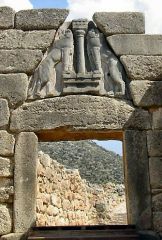
Formal Analysis The Lion Gate Proto Greece / Mycenaen 1,400 B.C.E.
Content -from a mycenaean citadel -above all of the common people(trade market, homes, etc.)
Style -moves away from post and lintel→ corbelled arch→ development of advanced engineering -horizontal stone=course |
The purpose of this piece was to fill the empty space in the corbelled arch and support it. The decoration is meant to ward of invaders. |
|
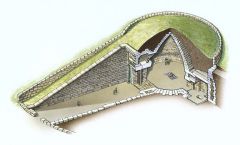
Formal Analysis Tholos Tombs "Treasure of Aretus" Proto Greece / Mycenaean 1,250 B.C.E
Content -king’ tomb -height and space is emphasized -dome shape -ancient Greece, for some reason didn’t utilize this innovation
Style -staggering of blocks -earth built up around it -didn’t have easily carvable limestone the egyptians had |
This temple was a funerary temple of a king. We know it has royal history because of the great wealth and riches found inside. However, what we focus on about this tomb is its use of the corbelled arch as a repeated pattern to create the first dome. This served as inspiration for all architecture to come. |
|
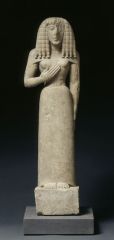
Formal Analysis Lady of Auxerre Kore Archaic Greek 650 BCE
Content -archaic-ancient, old, simple -basic pose -Kore→ “young woman” -wet drapery -slight smile→ characteristic of archaic greek sculpture
Style -made of limestone -2 ½ feet tall -treatment of the hair is stylized -modeled soft form→ getting ralistic -getting more detailed -geometric and realistic design |
This sculpture was made to depict either a goddess or a woman of significance/power. The sculpture itself reveals to us that the style of the times was going back to depicting things stylistically rather than naturally and realistically. |
|
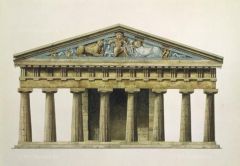
Formal analysis Temple of Artemis at Corfu Archaic Greek 600 B.C.E.
Content -example of first temples -pediments filled with high reliefs -pediment was used to depict and ornament the gods
Style -marble -painted |
This was NOT a funerary temple. It was a temple erected to the god, Artemis. The temple itself was meant for structure and stability rather than beauty and ornamentation. Its purpose was for worship and sacrifice to the gods. The purpose of the pediment was to tell the story of the god to which the temple was dedicated. |
|
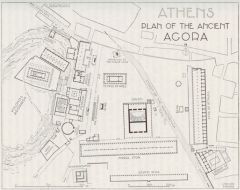
Formal Analysis 26. Athenian agora Archaic through Hellenistic Greek 600 B.C.E.–150 C.E.
Content -first meeting place amongst a city -economic place -market place -politics- decision making -center of the city & ancient Athens -sacked and destroyed and rebuilt
Style - comparative to washington DC - sits just below the acropolis |
The agora was a public, open space used for decision making around politics and economics. The agora was at the center of the city and was a place where markets, ideas, and people flourished. |
|
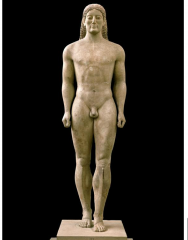
Formal Analysis 27. Anavysos Kouros Archaic Greek 530 B.C.E.
Content -Kouros - male statue -found in a cemetery (funerary plaque) -Kroisos - his family asked the artist to create (very specific idea in mind) -Kroisos dies in battle and had this statue erected at his grave
Style -natural, reflects the human shape -influenced by egyptian sculpture -made of marble -life size -inscription around the base lets us see the purpose -reflects the man not entirely in his own characteristics … stylized/geometric hair -accurate proportions (desire to learn size relationships) -archaic greek smile |
This statue is a funerary commemoration. IT was made in memory of Kroises, a soldier who died in battle. His parents were the patrons who requested that the sculpture would be made of him. I was placed at his grave. We know that this relates to funerary processes because of an inscription on the base of the piece. |
|

Formal Analysis 28. Peplos Kore from the Acropolis Archaic Greek 530 B.C.E.
Content -Kore -from the acropolis (high city) -thought to be wearing peplos (toga) -further research shows more layers of garments (show her elevated status)
Style -found buried in rubble and preserved for thousands of years (reveals original pigment) -archaic greek smile -marble -freed arm from the rest of the figure (missing) -stylized hair |
This sculpture comes from the acropolis. It depicts a woman of great power or elevated social status. It is believed that the missing left arm may have been holding an offering to the gods. This would have been the eminent purpose, to appease the gods. |
|
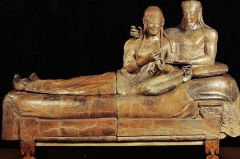
Formal Analysis 29. Sarcophagus of the Spouses Etruscan 520 B.C.E.
Content -etruscans- people who lived in the middle of italy during the archaic greek period (archaic italy) -may have been beginning of the roman empire -sarcophagus (funerary statuary) -couple (husband + wife)
Style -ashes found → rather than mummies (cremation) -sarcophagus placed in a tomb -made of terra cotta (hard, baked clay) -painted -cast and fired into 4 separate sections -4 ft. tall and over 6 ½ ft. long -human for slightly archaic and simple (still stylized) |
People of wealth could commission a sarcophagus to ensure their own/their loved ones security and comfort in the afterlife. This specific piece was a sarcophagus commissioned by a couple. It was placed within and Etruscan temple. |
|
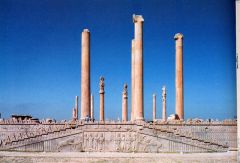
Formal Analysis 30. Audience Hall (apadana) of Darius and Xerxes Persepolis, Iran/Persian 520-465 B.C.E.
Content -Persia declined as Greeks developed themselves -Main gathering place for governing or royalty -Darius and Xerxes - Sons of Cyrus the Great (Persian king)
Style -Combination of Greek and Mesopotamia -Made of marble (marble from Greece) -Ziggurat (from ancient mesopotamia) -Columns (Greek) -hypostyle hall (egyptian) -capitals of columns speak to mesopotamian style (animal protoms) -animals back to back hold the beams
|
The audience hall was a meeting place for governors or royal officials. It was believed to have once held 10,000 people. This tells us that there was a necessity for an audience at times. It's possible that, due to the ornamentation, that this could have been very much for royal events. |
|
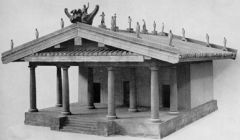
Formal analysis 31. Temple of Minerva and sculpture of Apollo Veii, near Rome, Italy / Master sculptor Vulca 510-500 B.C.E.
Content -built up with mud brick -plastered walls -one part of a huge complex reserved for burial of the dead
Style -Dominant pediment, columns, cornice, shaft -Stylobate leading up to only entrance -Simplified ornamentation -columns made of wood → painted and no flutes -Narrow front staircase→ restricts entrance to very few -Cella → three separate rooms of worship -Portico → open area in front of cella |
A man named Vitruvias wrote treaties of architecture that help us to understand this piece. We know that this was a temple for the gods. The temple had both a portico and a cella both used for worship and offerings. This temple also played a large role in establishing the staple for the roman temple. |
|
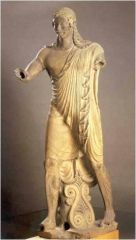
Formal Analysis 31. Sculpture of Apollo Veii, near Rome, Italy / Master sculptor Vulca 510-500 B.C.E.
Content -God of the sun (greek) -Pedimentry Statuary -More of a ceramics piece
Style -depicted in natural movement -armature helps to support his body in movements -made of terra cotta → painted |
This sculpture was meant to be on the roof of the Temple of Minerva. Its placement on the roof got it closer to the gods. It depicts the god, Apollo, as divine and beautiful and was meant to please him. |
|

Formal Analysis 32. Tomb of the Triclinium Tarquinia, Italy / Etruscan 480-470 B.C.E.
Content -Sunken, earthen, mud-brick temple -Banqueting couples -Men depicted with dark skin and women with light → this is a convention (like a rule of the times) -Banquet in celebration of someone's passing
Style -built up with mud brick -plastered walls -one part of a huge complex reserved for burial of the dead -massive in size -circular mounds -frescos → earliest form of painting (fresco secco - painting on dry plaster , buon fresco - painting on wet plaster *) -Stylized imagery -Suggestion of depth in a flat surface (foreshortening)
|
This tomb was meant to house the sarcophagus. We can infer that it was for someone of wealth because of the size and the intricate painting on the wall. Most likely, a wealthy patron purchased this tomb during their life. Other funerary items were placed in the tomb, however not to the extent of the Egyptian funerary processes. |
|
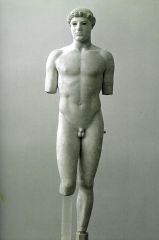
Formal Analysis Kritios Boy Classical Greek 480 B.C.E.
Content -young boy (no significance of who he is) - kritios may be sculptor or the name of the boy
Style -realism -made of marble -about 2 ½ feet tall -natural pose → demonstrates more natural human -contrapposto (pose that separates archaic from classical) → s-curve in the, shift of the hips, relaxed legs -soft modeling, rendering of the form (almost taking a breath) |
This piece most likely depicted a real person because of its level or naturalism and realism. It has no defined person because we are unsure of who the boy is. However, the piece plays a large role in defining the classic period form the archaic period. |
|
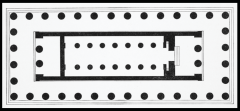
Formal Analysis Temple of Hera II at Paestum Classical Greek 460 B.C.E.
Content - establishes classic greek architecture - sits next to two other temples of Hera
Style -Colonnade → row of columns that run down the center to support the roof -split colonnade opens up the cella -stereobate and stylobate elevate the temple -peristyle = colonnade perimeter -symmetrical -approachable from any side -doric columns -alternating triglyphs and metopes |
This temple, both in it's decoration and sheer existence, tell the story of the goddess Hera. It praises her and marks her importance in the human world as well as the god world. Also, the fact that she has three temples, represents how vital and major she was the the Greeks. |
|

Formal analysis 33. Niobides Krater Anonymous vase painter of Classical Greece known as Niobid Painter 460-450 B.C.E.
Content -schematic illustration→ tell a story -depicts the massacre of neobid’s children -niobid challenged the goddess leido → leido had her children kill neobid’s children -message : never challenge the gods
Style -from = krater -wheel thrown -underglaze decoration -despite the humanism → still worships the gods -defines space → multi-tiered presentations of the figures -red clay → black glaze -decorated religious and secular buildings -sometimes found in cemeteries |
The purpose of this piece is to tell a story. It depicts the story of a massacre. It was most likely put on display in a religious or secular building. However, what is most important about this piece is that is creates the message: never challenge the gods. |
|
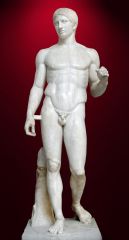
Formal Analysis 34. Doryphoros (Spear Bearer) Polykleitos Original 450-440 B.C.E.
Content -classical greece -supposed to be holding the spear -Polykleitos → sculptor → wrote his canon (rational that beauty resides in harmonious numerical ratios)
Style -contrapposto (stance) -structural supports -perfectly rendered figure (realistic as it comes)
|
Although this piece was not created for any known reason, it serves a purpose. The piece epitomized classical greek sculpture. It utilized humanism and realism to create the perfect form that was classical Greece. |
|
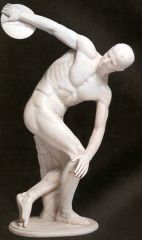
Formal Analysis Diskobolos (Discus Thrower) Myron / Athens, Greece / Classical Greek 450 BCE
Content -discus thrower → sport/game -athlete -natural man
Style -dynamic position → working with the perfect, natural form -structural support -almost life size (5’1”) |
After the development of "the perfect form", sculptures, like this one, became readily popular. Sculptors were able to manipulate the perfect/natural form into new positions and create dynamic pieces for all different purposes and patrons. |
|
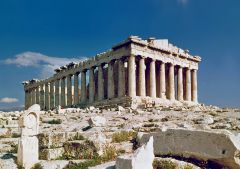
Formal Analysis 35. Acropolis - Parthenon Athens, Greece Iktinos and Kallikrates 447–424 B.C.E.
Content -entire complex -centrally located in Athens -contains government building, amphitheaters, temples -main temple: Parthenon → dedicated to Athena (at the center of acropolis)
Style -Propyla → grand entrance gates -perfect harmony and rationalism (architecture) -parthenon → doric temple (opposes other ionic temples at the same sight) - x=2y+1 (all constructed by this equation) |
The parthenon demonstrates the sheer wealth and military power of Athens. The temple itself is dedicated to Athena, however, it showcases human events and godly events side by side, demonstrating the principle of humanism as a common theme. |
|
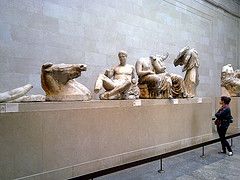
Formal Analysis 35. Acropolis - Helios, Horses, and Dionysus (hercules?) Athens, Greece Iktinos and Kallikrates 447–424 B.C.E.
Content -sculptural pediment (east pediment) -depict the birth of the goddess of Athena -centerpiece and right spectators removed -what remains: arm and head of helios, his chariot horses, Dionysus, more spectators (left to right) -Sculptor: Phidias
Style -flat backed and attached to the pediment -constructed to fit in the pedimentry triangle -ionic sculpture |
The purpose of this piece was to tell the story of the birth of Athena. The piece was located on the east pediment of the Parthenon and showcased the entire story for everyone to see. This is just one part of it. |
|

Formal Analysis 35. Acropolis - Temple of Athena Nike Athens, Greece Iktinos and Kallikrates 447–424 B.C.E.
Content -in honor of Athena
Style -flat walls on one side (brand new) -ionic style (volute son capitals) -freeze telling the story of the victory
|
This temple celebrates Athenian defeat over the Persians. Stylistic wise, it introduces a new style called amphiprostyle. |
|

Formal Analysis 35.Acropolis - Victory Adjusting her Sandal Athens, Greece Iktinos and Kallikrates 447–424 B.C.E.
Content -section of the freeze
Style -made of marble -natural depiction of fabric -naturalism 3 ½ feet high
|
This piece tells the story of Athenian defeat of the Persians. However, rather than celebrating Athena, it celebrates the Athenians, themselves. |
|
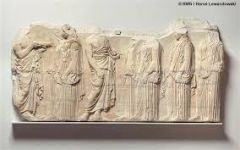
Formal Analysis 35. Acropolis - Plaque of the Ergastines Athens, Greece Iktinos and Kallikrates 447–424 B.C.E.
Content -comes from the frieze of the parthenon -depicts invited guests who watched the prosessions
Style -low relief on the bottom → as it moves up , higher relief (optical illusion) -made of marble |
This piece depicts the panathenaic festival of citizens (which celebrated the abilities of humans and their high sense of self worth). Essentially it tells a story.
|
|

Formal Analysis 36. Grave Stele of Hegeso Attributed to Kallimachos 410 B.C.E.
Content -funerary piece -gravestone -depicts a person other than hegosao -pictured with slave/maid -may have been a painted offering to the gods
Style -Hegeso depicted larger than the slave (shows hierarchical scale) -intimate scene for women to be shown -marble -painted -low relief |
The purpose of this piece was to mark the graves of the deceased. However, unlike ancient Egypt, these steles were not reserved for the upper class alone. What is unique about this piece is that while it is Greek, it pictures an intimate scene of the middle class. It showcases pride of all classes or people and is in celebration of humans. |
|
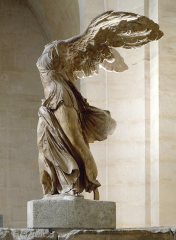
Formal Analysis 37. Winged Victory of Samothrace Hellenistic Greek 190 B.C.E.
Content -Hellenistic Greek Sculpture -messenger goddess who spreads the news of victory
Style -realistic rationalism -full of motion -highly ornamented fabric -marble -over 8 feet tall |
This piece represents glory. It epitomizes hellenistic Greece. Also, because of its placement on a ship, it represents the conquest of foreign lands. |
|
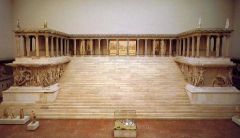
Formal Analysis 38. The Great Altar of Zeus and Athena at Pergamon Asia Minor (Present day Turkey) Hellenistic Greece 175 B.C.E.
Content -Temple erected to Zeus -Pergamon site on the top of a mountain
Style -Contains massive relief over 7 ft. tall that goes all the way around the temple -Hellenistic style -Colonnades in Ionic style -Expressiveness and drama |
The purpose of this altar was to recognize Zeus and Athena and their glory. It was a temple raised in their praise and was solely dedicated to them. The stories pictures in the relief are all of or relating to Zeus and Athena. The relief depicts a battle between the Giants and the Gods and Goddesses of Mt. Olympus. |
|

Formal Analysis Venus de Milo Hellenistic Greek 150 BCE
Content -goddess of love
Style -draping fabric -overly erotic depiction of a goddess |
The purpose of this sculpture was to depict the gods and goddesses as human like figures. This specific piece depicts Venus, the goddess of love, in a scandalous way, which was a whole new type of sculpture at the time. |
|
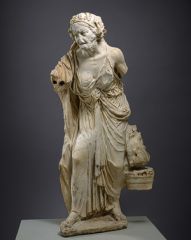
Formal Analysis Old Market Woman Hellenistic Greek 100 BCE
Content -Hellenistic sculpture - Depicts old women as a lower class women - Symbolic of generational conflict Style - marble -drapery -social realism
|
This sculpture depicts old women as old and decrepit lower class beings. This represents the respect given to the elderly. This piece portrays social realism. |
|
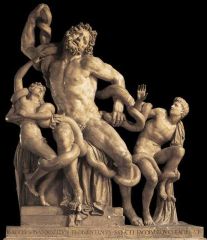
Formal Analysis Laocoon (and his sons) Hellenistic Greek 100 BCE
Content -regular person -was a priest -agony depicted in face - Was a man of Troy - new that the Trojan Horse was a fake - tried to warn the people - Greek goddess sent snakes after him and his sons
Style -humanism exaggerated by agony and pain in the facial expression -twisted figure - almost mimics a serpentine motion
|
This piece tells the story of Laocoon, a trojan who tried to expose the trojan horse. A Greek goddess sent snakes to stop him from telling the truth. There is great agony depicted in the piece. It shows both true beauty, and true emotion, a characteristic of Hellenistic Greece. |
|
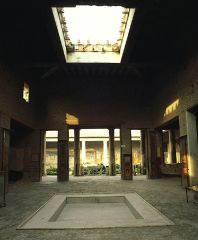
Formal Analysis 39. House of Vettii Imperial Roman / Pompeii, Italy Second century B.C.E. Rebuilt - 62–79 C.E.
Content -devastated in an earthquake (reconstructed) -social/group dwelling (as well as private and shops) -one large family, servants
Style -very large -contained markets/storefronts, private dwelling, and public social area domus → private area 2.Fauces → fauer (entrance) 3.Atrium → open court (catches water - sort of like a well) - Impluvium → rainwater basin 4.Alae → open rooms to rent out as shops -Cubicula → cubicles (used as bedrooms) 5.Garden 6. Dining-room 7.Painted room 8.Small courtyard 9.Bedroom 10.Kitchen -Courtyard surrounded by peristyle |
With this piece, the patrons, the homeowners, would essentially rent out portions of their home to be used as markets. The clients would be the shop owners, or artisans. Another purpose for this piece would be to be a private dwelling for the homeowner. |
|
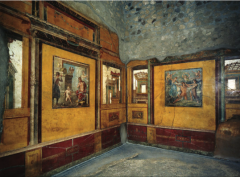
Formal Analysis 39. Ixion Room of the house of Vetti Imperial Roman / Pompeii, Italy Second century B.C.E. Rebuilt - 62–79 C.E.
Content -Paintings line the wall
Style --Tremendous illusion of depth (perspective) |
This piece was intended to be a decorative room with art in the new style. This piece was for beauty, not functionality. |
|
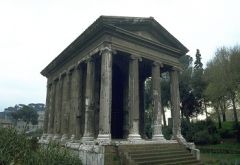
Formal Analysis Temple of “Fortuna Virilius” Republican Roman 100 BCE
Content - traditional republican roman style temple
Style -engaged columns (attached to stone blocks) -cella -decorative columns (only) -classic republican roman style |
This is a classic Republican Roman temple. It was used for offerings and worship. |
|

Formal Analysis 40. Alexander Mosaic from the House of Faun Pompeii, Republican Roman 100 B.C.E.
Content -mosaic -Great battle of Alexander the Great and Darius the III
Style -tesserae→ mosaic pieces made from glass and stone -incredible detail - shows depth and perspective |
This piece is a propaganda piece. It celebrates power and authority. |
|
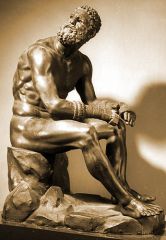
Formal Analysis 41. Seated Boxer Hellenistic Greece 100 B.C.E.
Content -focus on the common person -hellenistic emotion
Style -bronze (knew how to work with the materials) -completely intact -moving away from perfection -had a patina → surface finish on a bronze -sculpture portrays accurate texture
|
This piece demonstrates the common man. It shows agony and defeat which were uncommon Greek themes. However, this piece was made during the decline of Greece, therefore having themes that reflected the movements of society. |
|
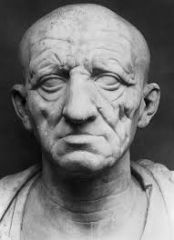
Formal Analysis 42. Head of a Roman Patrician Republican Roman 75-50 B.C.E.
Content -bust -common in ancient rome
Style -realism -very defined wrinkles -marble -eyes were painted
|
A bust was a piece that was used to honor a deceased family member. It was made of marble, so naturally only belonging to those of greater wealth. The piece would be placed inside the home as a remembrance of the person. Sometimes the family would parade around the home with the bust to further honor the dead relative. |
|

Formal Analysis 43. Augustus of PrimaPorta Imperial Roman Early First Century C.E.
Content -cesar -imperial rome ruled by the Cesar -cupid → reintroduced with non god/goddess figures
Style -classic imperial rome -the more beautiful the caesars became = more visual representation around the city to spread political/military strength -intimidating and all powerful |
This piece was a propaganda piece. It was used to demonstrate the power and authority of Roman Caesars. The goal was to get the citizens of Rome to stand behind the Caesar. This specific piece demonstrates the change between Republican and Imperial Rome. |
|

Formal Analysis 44. Colosseum (Flavian Amphitheater) Rome, Italy Imperial Roman 70-80 B.C.E.
Content -under the rule of Flavian
Style -combo of concrete and stone -3 tiers -plus one ornamental tier -comprised of a series of arches -awe inspiring -used to be a retractable wood/cloth roof -series of engaged column, arch, and entablature -incorporates all three orders of architecture (displayed in the capital) → created optical illusion of lightness -one fit 45,00,-55,000 -barrel vaults lead into actual seating (sculpture within each) |
The Colosseum is the staple piece of Roman Architecture. It is yet another propaganda piece showing the power and ability of the Romans. The colosseum was used for different types of entertainment for the roman people. |
|
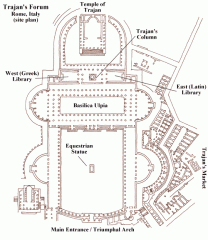
Formal Analysis 45. Forum of Trajan, Reconstruction drawing, Basilica Ulpia (reconstruction drawing), Trajan Markets, Column of Trajan Rome, Italy Apollodorus of Damascus Forum and markets: 106–112 C.E Column completed 113 C.E.
Content -Becomes ideal Christian Church → starts out Roman
Style -triumphal arch as entrance -huge open courtyard surrounded by colonnade → Inside this was the equestrian statue -Basilica (meeting area for politics) (two stories) -temple of Trajan (back of the forum) -libraries (borrowed from Greeks) -Trajans column (similar to obelisk) (carefully carved in low relief) |
The forum of Trajan celebrates the triumphs of Rome. Each Caesar created a piece that would demonstrate their power and glory. Each on of these pieces were propaganda. The forum was surrounded by very popular markets. Erected in front of the forum is the column of Trajan, similar to an abelisk. |
|
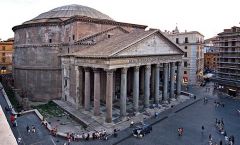
Formal Analysis 46. Pantheon Imperial Roman 118–125 C.E.
Content -Built by Hadrian -full potential of concrete (and stone) -tradition and innovation literally stuck together
Style -Entrance way is a portico (only borrowed element) -huge concrete dome -Many innovations concrete dome oculus stepped dome coiffered ceiling drum (base of the dome) rotunda (round interior space)
|
This was a temple for all of the gods. It demonstrates the full potential of concrete as a building material. The building itself represents the strength and innovation of the Romans. |
|
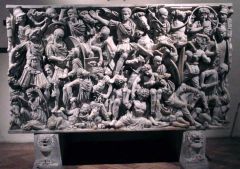
Formal Analysis Ludovisi Battle Sarcophagus Late Imperial Roman 250 C.E. |
. |

